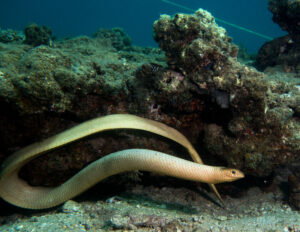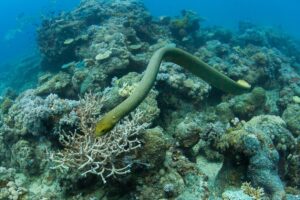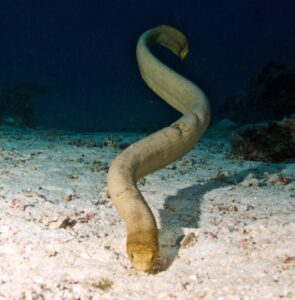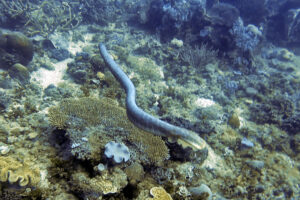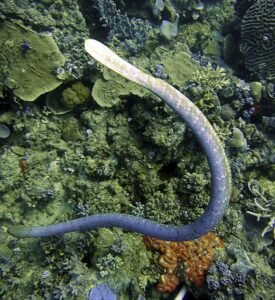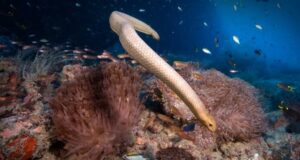The olive sea snake, also called the golden sea snake or olive-brown sea snake, is a species in the elapid family. It gets the common name due to its body coloration and is considered one of the ‘true sea snakes’.
Unlike most marine reptiles, this species’ entire life cycle is underwater, even though they have lungs and must breathe air.
In 1804, French naturalist Bernard Germain de Lacépède first described this species. Their genus name ‘Aipysurus‘ derives from the Greek words aipys, meaning “high and steep”, and oura, meaning “tail”. The term loosely translates to “high tail”, denoting this genus’ side-to-side flattened tail higher than the body’s depth. And the species epithet ‘laevis‘ is a variant form of the Latin, which means “smooth”.
Scientific Classifications
- Suborder:Serpentes
- Family:Elapidae
- Genus:Aipysurus
- Species:A.laevis
Conservation Status
Subspecies
The olive sea snake has two known subspecies:
- Olive Sea Snake (A. l. laevis)
- Shark Bay Sea Snake (A. l. pooleorum)
Description
Size
They grow up to 3.2-6.5 feet (1-2 m) with a weight of 6.6 lbs (3 kg).
Color and Appearance
These snakes have slightly compressed slender bodies with a brownish to light olive-brown and purple upper part, pale spots on the sides, and white undersides. They have short and wide yellowish-olive colored heads with two small eyes and a flattened paddle-like tail adapted for swimming. Their large lungs allow them to remain underwater for a long time without breathing at the surface.
Are they Dangerous
The olive sea snakes are highly venomous and dangerous species. Their potent neurotoxic venom has an LD50 value of 0.22 mg/kg and a yield of 10 – 33 mg per bite.
The bites of olive sea snakes are fatal, causing paralysis and death. After being bitten, victims may experience initial symptoms within five minutes to two hours which include anxiety, body aches, confusion, diarrhea, drowsiness, dryness of the throat, fatigue, headaches, nausea, the sensation of a thick tongue, stiffness of the body and neck, pain, vomiting, and weak muscles. Victims are advised to seek medical help right away since immediate treatment is essential if bitten by this snake.
They are not too aggressive and won’t likely attack if not threatened. Some curious individuals may inquisitively approach divers but will not attack unless they are being disturbed or consider them a threat. During the mating season, the males show aggressive behavior, which causes more human encounters leading to increased chances of snakebites.
Olive Sea Snake At a Glance
Distribution
These sea snakes are most common along the northern Australian coastline and islands nearby. Their distribution ranges from Exmouth on the northeast coast of Western Australia to the Loyalty Islands of New Caledonia, as well as Queensland, including the Great Barrier Reef on the east, towards New Guinea, and across the tropical waters of the southwest Pacific Ocean.
Habitat
Olive sea snakes prefer to inhabit estuaries, coral reefs, and tropical shallows. They usually do not use the same site for shelter. Being in shallow areas about 32-131 ft deep allows them to reach the surface quickly and breathe oxygen. These snakes can be found 230 ft deep below sea level.
When they are not hunting or coming up to the surface to breathe, olive sea snakes take cover inside small coves around the reefs, hiding throughout the day. They can stay underwater without breathing for up to two hours.
Lifespan
These snakes live up to 15 years in the wild.
Predators
The predators of this species include birds like ospreys, large bony reef fish, and even sharks.
Photoreceptors have been found on the tail’s skin surface of the olive-brown sea snake, which allows them to detect light. This helps them to stay hidden from predators entirely, including their tails.
Diet
They consume medium-sized fishes and benthic invertebrates like crabs, crustaceans, mollusks, and prawns. Sometimes they may feed on fish eggs.
Golden sea snakes are nocturnal creatures that actively hunt during the night around the coral reefs and tend to avoid the open water for hunting. They are very aggressive regarding their prey. After locating it, they inject their venom and coil around the prey with great strength until it stops moving, then swallow it whole. Their venom is designed in such a way that it helps to break down the prey’s organs and makes it easier to digest.
Reproduction
Breeding occurs from May through July, and several males attempt to mate with the same female. Mating generally takes place on the sea floor.
After nine months of gestation, females give live birth to about 6-8 young, and rarely 10-11. Older females produce more newborns than younger ones. Reproduction typically happens once at an interval of two years.
Newborns are darker in color and develop a lighter hue as they grow. Males and females become sexually mature at three and five years old respectively.
Similar Species
Arafura Sea Snake
The Arafura and olive sea snakes have a similar distribution in Western Australia. These snakes have similar looking heads, but the Arafura sea snake’s body is paler and slimmer than the olive sea snake.
FAQs
Ans: The main difference is the olive sea snake is a reptile that lives in coral reefs, and the hagfish is a fish that inhabits the murky ocean bottom. Olive sea snake needs to come to the surface and breathe oxygen, whereas hagfish can breathe underwater.
Ans: Being sea snakes, they can swim at high speed due to their oar-like flat tails and slightly compressed bodies. Also, their nasal valves are engorged with blood that prevents air from entering the lungs while diving underwater.
Source
ourbreathingplanet.com, biosphereonline.com, snakeradar.com, livingoceansfoundation.org,

